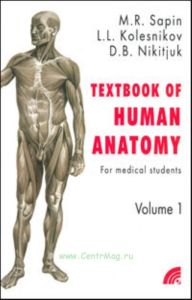Анатомия человека: Учебное пособие для студентов медицинских вузов на английском языке (Textbook of human anatomy) в двух книгах. Кн. 1
В пособии изложен курс анатомии человека, необходимый для последующего изучения медико-биологических и клинических дисциплин. Учебный материал изложен логично, компактно, на современном научном уровне и хорошо иллюстрирован. Объем и глубина изложения материала соответствует уровню подготовки, необходимому для студентов медицинских вузов.
Для студентов медицинских вузов, аспирантов, врачей.
CONTENTS
Preface
Introduction
Planes and axes. General anatomical terms
THE STRUCTURE OF THE HUMAN BODY
Cells and tissues
Cells
Transport of substances and membranes in the cell
The nucleus
Cell division. The cell cycle
Tissues
Epithelial tissue
Connective tissue
The Blood
Skeletal tissues
Cartilage
Bone tissue
Muscle tissue
Nervous tissue
MAIN STAGES OF DEVELOPMENT IN ONTOGENESIS LOCOMOTION APPARATUS
Structure of bones
Classification of bones
Structure and chemical composition of bones
Development and growth of bones
Skeleton of the trunk
Vertebrae
Cervical vertebrae
Thoracic vertebrae
Lumbar vertebrae
Sacrum
Coccyx
Ribs and sternum
Sternum
Main variants and anomalies of bones of the trunk
The skull
Bones of the cranial skull
Canals of the temporal bone
Bones of the facial skull
Skull as a whole
Paranasal sinuses
Skull of a newborn
Modifications of the skull after birth
Sexual characteristics of the skull
Development of the human skull
Variants and anomalies in development of the bones of the skull
The appendicular skeleton
Bones of the upper extremities
The pectoral girdle
Skeleton of the free upper extremities
Bones of the forearm
Bones of the hand
Variants and anomalies of the skeleton of the upper extremities
Bones of the lower extremities
Bones of the pelvic girdle
Skeleton of the free lower extremity
Bones of the leg
Bones of the foot
Variants and anomalies of the skeleton of lower extremities
JOINTS
Classification of joints
Classification of joints (continuation)
Age characteristics of joints
Articulations of the bones of the trunk
Joints of the vertebral column
Articulations between the vertebral column and skull
The vertebral column (as a whole)
Articulation of ribs with the vertebral column
Articulation of the ribs with the sternum
The thorax (as a whole)
Articulations of the bones of the skull
Articulations of the upper extremities
Articulations of the pectoral girdle
Articulations of the free upper extremity
Articulations of the forearm and hand
Movement in joints of the hand
Articulations of the lower extremities
Articulations of the pelvic girdle
The pelvis (as a whole)
Articulations of the free lower extremity
Articulations of the bones of the leg
Articulations of the bones of the foot
The foot as a whole
THE MUSCULAR SYSTEM
Structure of the skeletal muscles
Classification of muscles
The auxiliary apparatus of muscles
Work of muscles
Development of muscles
Muscles and fasciae of the back
Superficial muscles of the back
Deep muscles of the back
Fasciae of the back
Topographic anatomy and fatty tissue spaces of the back
Muscles and fasciae of the thorax
Proper muscles of the thorax .
Fasciae of the thorax
Topographic anatomy and fatty tissue spaces of the torax
Muscles and fasciae of the abdomen
Muscles of the posterior abdominal wall
Fasciae of the abdominal region
Topographic anatomy and fatty tissue spaces of the abdominal walls
Linea alba of the abdomen
The rectus sheath
The inguinal canal
Muscles and fasciae of the head
Muscles of fasial expression
Muscles of the roof of the skull
Muscles of the eyelid and the orbit
Muscles of the nose
Muscles of the mouth
Muscles of the auricular concha
Masticatory muscles
Fasciae of the head
Topographic anatomy and fatty tissue spaces of the head
Muscles and fasciae of the neck
Superficial muscles of the neck
Muscles situated above the hyoid bone
Muscles situated below the hyoid bone
Deep muscles of the neck
Topographic anatomy and fatty tissue spaces of the neck
Triangles of the neck
Muscles and fasciae of the upper extremity
Muscles of the shoulder girdle
Muscles of the free upper extremity
Anterior muscles of the arm
Posterior muscles of the arm
Anterior muscles of the forearm
First (superficial) layer of the anterior muscles of the forearm
Second layer of the anterior muscles of the forearm
Third layer of anterior muscles of the forearm
Fourth (deep) layer of the anterior muscles of the forearm..
Posterior muscles of the forearm
Superficial layer of the posterior muscles of the forearm
Deep layer of the posterior muscles of the forearm
Muscles of the hand
Muscles of the thenar eminence
Muscles of the hypothenar
Middle group of the muscles of the hand
Fasciae and synovial bursae of the upper extremity
Topographic anatomy and fatty tissue spaces of the upper extremity
Muscles and fasciae of the lower extremity
Muscles of the pelvic girdle (muscles of the pelvis)
Internal muscles of the pelvic girdle
External muscles of the pelvic girdle
Muscles of the free lower extremity
Anterior muscles of the thigh
Posterior muscles of the thigh
Medial muscles of the thigh
Muscles of the leg
Anterior muscles of the leg
Lateral muscles of the leg
Posterior muscles of the leg
Superficial layer
Deep layer of the posterior group of the leg muscles
Muscles of the foot
Dorsal muscles of the foot
Medial group of the muscles of the sole
Lateral group of muscles of the sole
Middle group of the muscles of the sole
Fasciae, synovial bursae and sheaths of the lower extremity
Topographic anatomy and fatty tissue spaces of the lower extremity
Variants and anomalies of the skeletal muscles
Muscles of the trunk
Muscles of the chest
Muscles of abdomen
Muscles of facial expression
Muscles of mastication
Muscles of the neck
Muscles of the upper extremity
Muscles of the lower extremities
SPLANCHNOLOGY (THE STUDY OF INTERNAL ORGANS) ..
Topographic orientation points of internal organs
The digestive system
The oral cavity
Palate
Teeth
Tongue
Salivary glands
Pharynx
Oesophagus
Stomach
Small intestine
Duodenum
Jejunum and Ileum
Large intestine
Liver
Biliary system
Gallbladder
Pancreas
Peritoneum
Development of the digestive system
Age characteristics of the digestive system organs
Variants and anomalies of the digestive organs
The respiratory system
Nose
Nasal cavity
Larynx
Trachea
Main bronchi
Lungs
Pleura
Mediastinum
Development of the respiratory system
Рекомендуем








